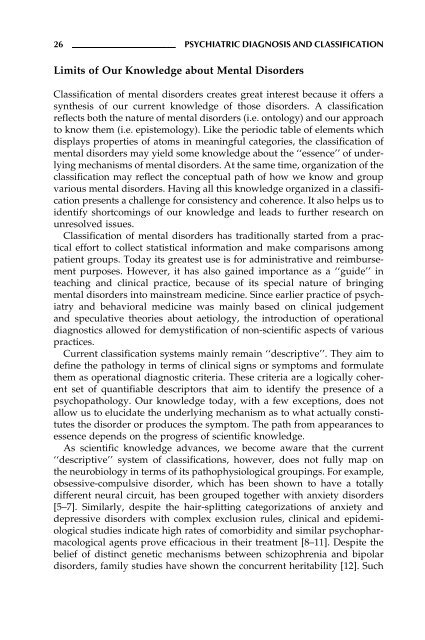Psychiatric Diagnosis and Classification - ResearchGate
Psychiatric Diagnosis and Classification - ResearchGate
Psychiatric Diagnosis and Classification - ResearchGate
Create successful ePaper yourself
Turn your PDF publications into a flip-book with our unique Google optimized e-Paper software.
26 PSYCHIATRIC DIAGNOSIS AND CLASSIFICATION<br />
Limits of Our Knowledge about Mental Disorders<br />
<strong>Classification</strong> of mental disorders creates great interest because it offers a<br />
synthesis of our current knowledge of those disorders. A classification<br />
reflects both the nature of mental disorders i.e. ontology) <strong>and</strong> our approach<br />
to know them i.e. epistemology). Like the periodic table of elements which<br />
displays properties of atoms in meaningful categories, the classification of<br />
mental disorders mayyield some knowledge about the ``essence'' of underlying<br />
mechanisms of mental disorders. At the same time, organization of the<br />
classification mayreflect the conceptual path of how we know <strong>and</strong> group<br />
various mental disorders. Having all this knowledge organized in a classification<br />
presents a challenge for consistency<strong>and</strong> coherence. It also helps us to<br />
identifyshortcomings of our knowledge <strong>and</strong> leads to further research on<br />
unresolved issues.<br />
<strong>Classification</strong> of mental disorders has traditionallystarted from a practical<br />
effort to collect statistical information <strong>and</strong> make comparisons among<br />
patient groups. Todayits greatest use is for administrative <strong>and</strong> reimbursement<br />
purposes. However, it has also gained importance as a ``guide'' in<br />
teaching <strong>and</strong> clinical practice, because of its special nature of bringing<br />
mental disorders into mainstream medicine. Since earlier practice of psychiatry<strong>and</strong><br />
behavioral medicine was mainlybased on clinical judgement<br />
<strong>and</strong> speculative theories about aetiology, the introduction of operational<br />
diagnostics allowed for demystification of non-scientific aspects of various<br />
practices.<br />
Current classification systems mainly remain ``descriptive''. They aim to<br />
define the pathologyin terms of clinical signs or symptoms <strong>and</strong> formulate<br />
them as operational diagnostic criteria. These criteria are a logicallycoherent<br />
set of quantifiable descriptors that aim to identifythe presence of a<br />
psychopathology. Our knowledge today, with a few exceptions, does not<br />
allow us to elucidate the underlying mechanism as to what actually constitutes<br />
the disorder or produces the symptom. The path from appearances to<br />
essence depends on the progress of scientific knowledge.<br />
As scientific knowledge advances, we become aware that the current<br />
``descriptive'' system of classifications, however, does not fully map on<br />
the neurobiologyin terms of its pathophysiological groupings. For example,<br />
obsessive-compulsive disorder, which has been shown to have a totally<br />
different neural circuit, has been grouped together with anxietydisorders<br />
[5±7]. Similarly, despite the hair-splitting categorizations of anxiety <strong>and</strong><br />
depressive disorders with complex exclusion rules, clinical <strong>and</strong> epidemiological<br />
studies indicate high rates of comorbidity<strong>and</strong> similar psychopharmacological<br />
agents prove efficacious in their treatment [8±11]. Despite the<br />
belief of distinct genetic mechanisms between schizophrenia <strong>and</strong> bipolar<br />
disorders, familystudies have shown the concurrent heritability[12]. Such

















